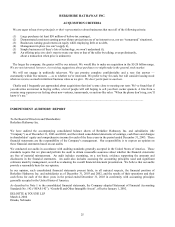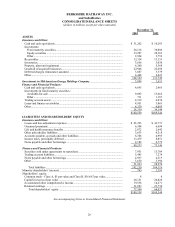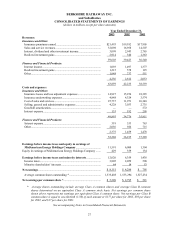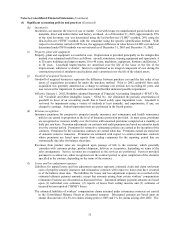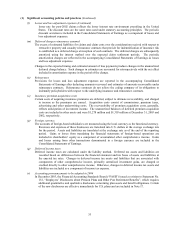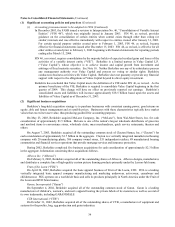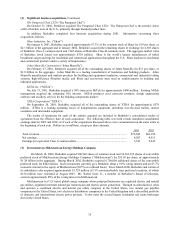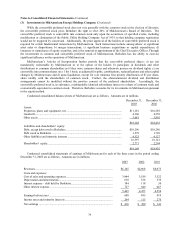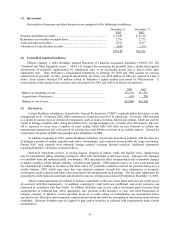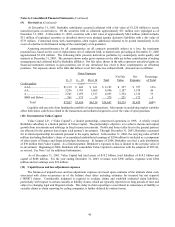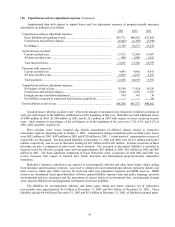Berkshire Hathaway 2003 Annual Report Download - page 33
Download and view the complete annual report
Please find page 33 of the 2003 Berkshire Hathaway annual report below. You can navigate through the pages in the report by either clicking on the pages listed below, or by using the keyword search tool below to find specific information within the annual report.32
Notes to Consolidated Financial Statements (Continued)
(1) Significant accounting policies and practices (Continued)
(h) Inventories
Inventories are stated at the lower of cost or market. Cost with respect to manufactured goods includes raw
materials, direct and indirect labor and factory overhead. As of December 31, 2003, approximately 59%
of the total inventory cost was determined using the last-in-first-out (“LIFO”) method, 28% using the
first-in-first-out (“FIFO”) method, with the remainder using the specific identification method. With
respect to inventories carried at LIFO cost, the aggregate difference in value between LIFO cost and cost
determined under FIFO methods was not material as of December 31, 2003 and December 31, 2002.
(i) Property, plant and equipment
Property, plant and equipment is recorded at cost. Depreciation is provided principally on the straight-line
method over estimated useful lives as follows: aircraft, simulators, training equipment and spare parts, 4
to 20 years; buildings and improvements, 10 to 40 years; machinery, equipment, furniture and fixtures, 3
to 20 years. Leasehold improvements are amortized over the life of the lease or the life of the
improvement, whichever is shorter. Interest is capitalized as an integral component of cost during the
construction period of simulators and facilities and is amortized over the life of the related assets.
(j) Goodwill of acquired businesses
Goodwill of acquired businesses represents the difference between purchase cost and the fair value of net
assets of acquisitions accounted for under the purchase method. Prior to 2002, goodwill from each
acquisition was generally amortized as a charge to earnings over periods not exceeding 40 years, and
was reviewed for impairment if conditions were identified that indicated possible impairment.
Effective January 1, 2002, Berkshire adopted Statement of Financial Accounting Standards (“SFAS”) No.
142 “Goodwill and Other Intangible Assets.” SFAS No. 142 eliminated the periodic amortization of
goodwill in favor of an accounting model that is based solely upon impairment tests. Goodwill is
reviewed for impairment using a variety of methods at least annually, and impairments, if any, are
charged to earnings. Annual impairment tests are performed in the fourth quarter.
(k) Revenue recognition
Insurance premiums for prospective property/casualty insurance and reinsurance and health reinsurance
policies are earned in proportion to the level of insurance protection provided. In most cases, premiums
are recognized as revenues ratably over their terms with unearned premiums computed on a monthly or
daily pro rata basis. Premium adjustments on contracts and audit premiums are based on estimates made
over the contract period. Premiums for retroactive reinsurance policies are earned at the inception of the
contracts. Premiums for life reinsurance contracts are earned when due. Premiums earned are stated net
of amounts ceded to reinsurers. Premiums are estimated with respect to certain reinsurance contracts
where premiums are based upon reports from ceding companies for the reporting period that are
contractually due after the balance sheet date.
Revenues from product sales are recognized upon passage of title to the customer, which generally
coincides with customer pickup, product shipment, delivery or acceptance, depending on terms of the
sales arrangement. Service revenues are recognized as the services are performed. Services provided
pursuant to a contract are either recognized over the contract period, or upon completion of the elements
specified in the contract, depending on the terms of the contract.
(l) Losses and loss adjustment expenses
Liabilities for unpaid losses and loss adjustment expenses represent estimated claim and claim settlement
costs of property/casualty insurance and reinsurance contracts with respect to losses that have occurred
as of the balance sheet date. The liabilities for losses and loss adjustment expenses are recorded at the
estimated ultimate payment amounts, except that amounts arising from certain workers’ compensation
reinsurance business are discounted as discussed below. Estimated ultimate payment amounts are based
upon (1) individual case estimates, (2) reports of losses from ceding insurers and (3) estimates of
incurred but not reported (“IBNR”) losses.
The estimated liabilities of workers’ compensation claims assumed under reinsurance contracts are carried
in the Consolidated Balance Sheets at discounted amounts. Discounted amounts are based upon an
annual discount rate of 4.5% for claims arising prior to 2003 and 1% for claims arising after 2002. The





